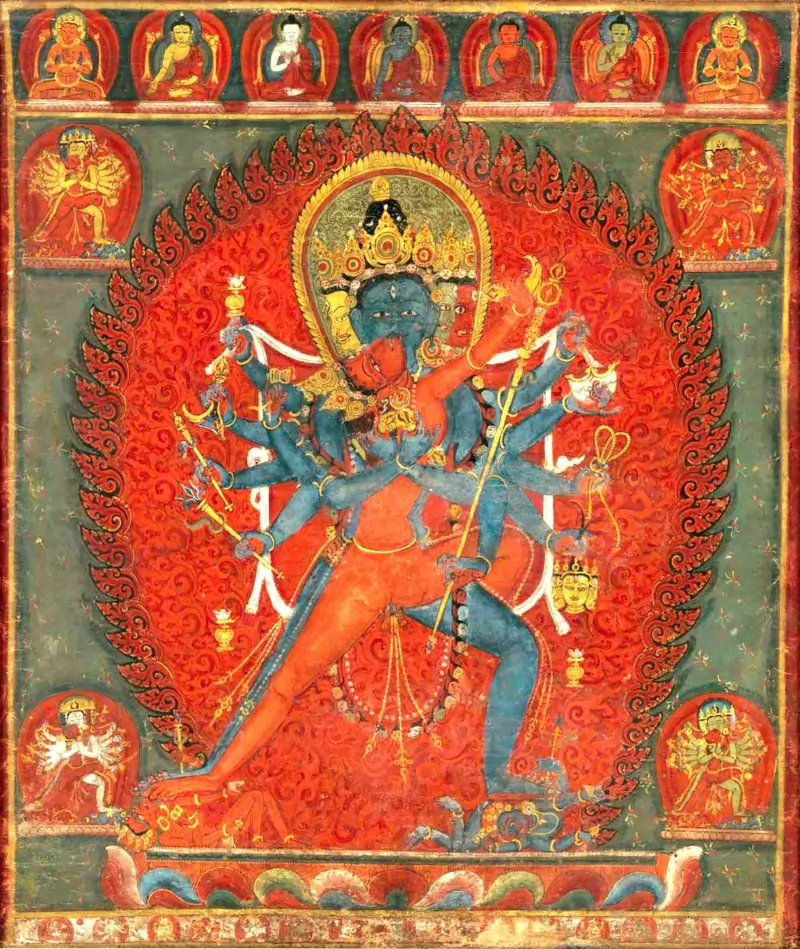Newar Buddhism: Embracing Chakrasamvara and Vajravarahi
Newar Buddhism, a unique form of Vajrayana Buddhism practiced primarily in Nepal, is deeply rooted in the cultural and religious tapestry of the Newar people. This tradition prominently features the worship of deities such as Chakrasamvara and Vajravarahi, who are revered in the esoteric practices of Tibetan Buddhism as well. In Newar Buddhism, these deities are not just symbolic representations but are considered to be powerful guides towards spiritual enlightenment. The Bajracharya Buddhists, a prominent Newar Buddhist community, engage in intricate rituals and dedicated prayers to these deities, viewing them as pivotal in their spiritual journey. These practices underscore the rich and diverse nature of Vajrayana Buddhism in Nepal, highlighting its unique integration of local beliefs and practices.
Bridging Worlds: Bajracharya Buddhism and Its Tibetan Connection
At its core, Bajracharya Buddhism shares a profound connection with Tibetan Buddhism. This bond is most evident in their mutual reverence for deities like Chakrasamvara and Vajravarahi. Both traditions immerse themselves in a rich tapestry of rituals and teachings, illustrating a shared spiritual lineage that transcends geographical boundaries.
The Essence of Chakrasamvara Tantra
The Chakrasamvara Tantra, a pivotal text in the Vajrayana Buddhist tradition, represents a profound and intricate spiritual system that transcends mere religious doctrine. It embodies the essence of tantric practice, offering a path to enlightenment through the integration of mind, body, and spirit. This ancient scripture, revered for its depth and complexity, guides practitioners in a transformative journey toward spiritual awakening, harmonizing the seemingly paradoxical elements of mundane existence with the ultimate pursuit of spiritual liberation. It stands as a beacon of enlightenment, emphasizing the union of wisdom and method, and is central to the practices centered around the deities Chakrasamvara and Vajravarahi, symbolizing the male and female aspects of divine energy and consciousness.
Chakrasamvara: The Supreme Deity
Chakrasamvara, the male deity, in Sanskrit चक्रसंवर, as his name translates to “Circle of Bliss”, embodies the union of compassion and wisdom. With a striking appearance characterized by his calmer face and twelve arms, each holding a unique attribute, Chakrasamvara symbolizes the conquest of desires and ego. He teaches his devotees the path of transcending ordinary existence by embracing the profound wisdom of emptiness and the blissful nature of reality. Worshippers of Chakrasamvara engage in practices that symbolize the transcendence of earthly desires and the attainment of a higher state of being.
He is typically depicted with a powerful and commanding presence, featuring four faces, each expressing a different aspect of enlightenment, and twelve arms, symbolizing the conquering of various spiritual obstacles. His blue-hued body, often in a dynamic dance posture, represents the limitless sky and the vastness of Buddhist teachings, while his embrace with his consort, Vajravarahi, illustrates the inseparable nature of wisdom and compassion in the path to enlightenment.
Vajravarahi: The Radiant Companion
Vajravarahi, the female deity, in Sanskrit वज्रवाराही, often referred to as Vajrayogini (वज्रयोगिनी), is the radiant consort of Chakrasamvara. She represents the embodiment of wisdom and the transformative power of feminine energy. Vajravarahi is revered as a guide who leads her devotees towards a state of pure awareness, free from the entanglements of the mundane world.
Her red body and fierce expression symbolize her ability to cut through ignorance and attachments. Her form, skull cup filled with blood and curved knife, resonates with deep symbolism, representing the transcendence of earthly attachments and the cutting through of ego and illusion. Vajravarahi epitomizes the female principle of enlightenment, merging fierce strength with transcendent wisdom.
Recognizing Charasamvara and Vajravarahi
To recognize Chakrasamvara and Vajrabarahi, it’s important to note that Chakrasamvara is depicted in blue, with multiple heads and arms, and a calmer expression. He is shown embracing the red Vajrabarahi (Vajrayogini), characterized by a single head and standard arms and legs, representing feminine strength.
Concluding Reflections: Embracing the Path of Enlightenment
In conclusion, Chakrasamvara and Vajravarahi stand as beacons in the Bajracharya Buddhist traditions, guiding followers towards spiritual awakening. Their teachings, rooted in the ancient Chakrasamvara Tantra, continue to inspire and enlighten those on the path to enlightenment. These deities, with their profound symbolism and transformative practices, remind us of the endless potential within each individual to transcend the mundane and achieve a state of higher consciousness. Their enduring presence in the Agama prayer room is a testament to the timeless journey of spiritual discovery and enlightenment.

